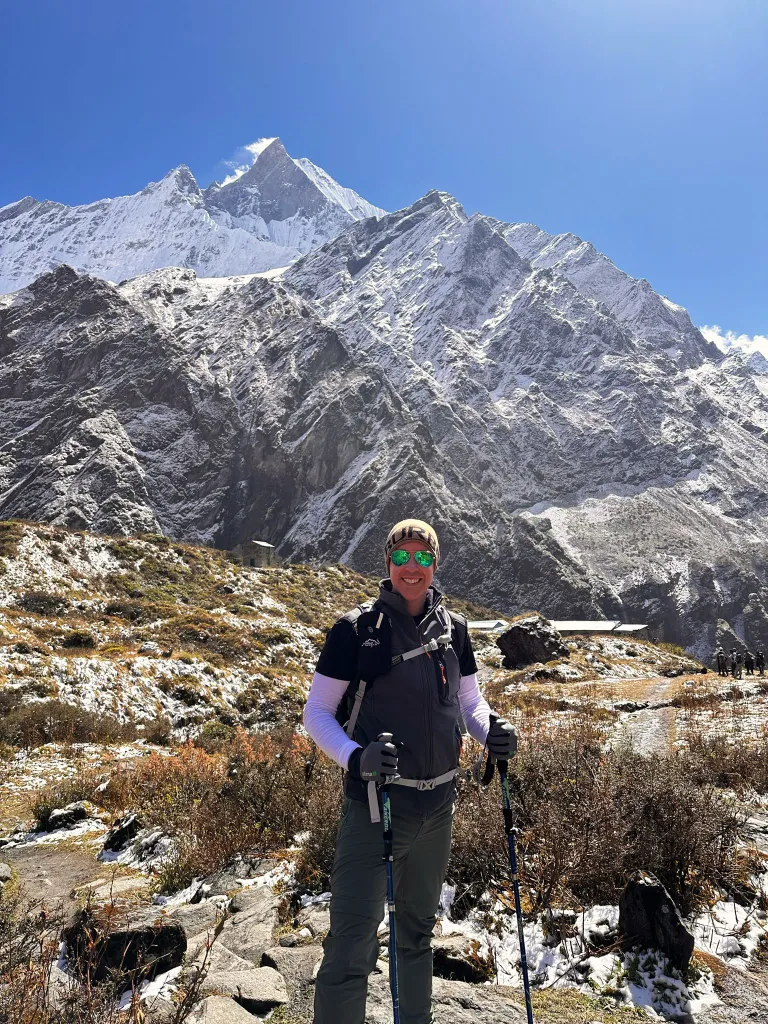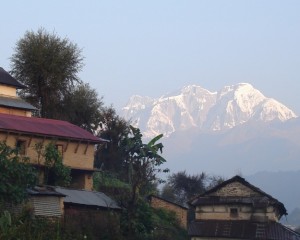Pisang Peak Climbing: A complete Guide
You are looking for a epic adventure in the off beaten trail and peaks. It is time for you to get ready for the adventure to the majestic Pisang Peak.
It stands tall at 6,091 meters that offers an awe-inspiring views that will leave you speechless. Pisang peak is located within the stunning Annapurna Conservation Area with promise of the adrenaline pumped challenge and the amazing rewards.
Both seasoned climbers and adventurous trekkers get to have an exhilarating challenge and breathtaking vistas.
So, without any delay let us find out all about the Pisang Peak ?
Highlights of the Pisang Peak
When you're trekking to Pisang Peak, there are awesome things to see and do along the way. You'll see lush green valleys and amazing landscapes that look like they're straight out of a painting!
One of the best parts is checking out Pisang village itself. It's surrounded by these huge mountains that make you feel tiny! You can learn about local life, see old temples, and even catch sight of colorful prayer flags fluttering in the breeze.
And don't forget about the views! As you trek, you'll get to see some of the most breathtaking sights you've ever laid eyes on. Snowy peaks like Annapurna and Manaslu will be right there in front of you, showing off their majestic beauty.
Plus, the whole area is part of the Annapurna Conservation Area each turn is going to be stunning!

Overview of the Pisang Peak
The journey to Pisang Peak starts in Kathmandu the bustling capital city. From there, you'll start on a scenic drive to Besisahar, the gateway to the Annapurna region. As you trek, you'll pass through beautiful villages like Bahundanda, Chamje, and Dharapani with a glimpse into local culture and lifestyle.
The landscape along the route is diverse and breathtaking from lush green valleys to rugged mountain terrain. You'll trek through dense forests, cross suspension bridges over rushing rivers, and ascend to higher altitudes as you make your way to the base camp of Pisang Peak.
Along the way, you'll be treated to stunning views of snow-capped peaks, including the towering Annapurna and Manaslu ranges. The journey is about immersing yourself in the natural beauty of the Himalayas and experiencing the rich culture of the region.
Itinerary of the Pisang Peak from the Nepal Vision Trek
- Day 1: Arrival in Kathmandu (1,300m/4,264 ft)
- Day 2: Kathmandu City Tour and Trip Preparation
- Day 3: Drive to Besisahar (830m/2,723ft) - 5-6 hrs drive
- Day 4: Trek to Bahundanda (1,310m/4,298ft) - 5-6 hrs walk
- Day 5: Trek to Chamje (1,410m/4,626ft) - 5-6 hrs walk
- Day 6: Trek to Dharapani (1,960m/6,430ft) - 5-6 hrs walk
- Day 7: Trek to Chame (2,710m/8,891ft) - 6-7 hrs walk
- Day 8: Trek to Pisang (3,700m/12,139ft) - 5-6 hrs walk
- Day 9: Trek to Upper Pisang Base Camp (4,380 m/14,36ft) - 3-4 hrs walk
- Day 10: Trek to High Camp ( 5,400m/17,712ft) - 3-4 hrs walk
- Day 11: Summit Pisang Peak (6,092m/19,982ft) & Hike back to Upper Pisang - 7-9 hrs
- Day 12: Reserve Day for Climbing
- Day 13: Trek to Manang (3,500m/11,482ft) - 4-5 hrs walk
- Day 14: Trek to Yak Kharka (4,110m/13,484ft) - 3-4 hrs walk
- Day 15: Trek to Thorong Phedi (4,400m/14,432) - 3-4 hrs walk
- Day 16: Trek to Thorong La Pass (5,416m/17,765 ft) to Muktinath (3,800/12,467ft) - 7-8 hrs walk
- Day 17: Trek to Jomsom (2,570m/8,430ft) - 5-6 hrs walk
- Day 18: Flight from Jomsom to Pokhara (25 minutes)
- Day 19: Drive from Pokhara to Kathmandu - 5-6 hrs drive
- Day 20: Departure from Kathmandu
How to prepare for the pisang peak climbing training ?
Before starting on Pisang Peak Climbing, it's essential to ensure you're physically fit. The trek involves challenging terrain and high altitudes that requires good cardiovascular endurance and strength.
To prepare, engage in regular cardiovascular exercises like hiking, jogging, or cycling to improve stamina. Include strength training exercises focus on core muscles, legs, and upper body to build strength for carrying gear and finding steep slopes.
The practice of altitude acclimatization techniques, such as ascending gradually and staying hydrated help to reduce the risk of altitude sickness during the climb.
How to plan for the pisang peak ?
Pisang Peak is one of the fantastic journey. But before you start on the journey there are lots of things to prepare for.
Best season
The best seasons for Pisang Peak Climbing are generally from September to November (fall) and March to May (spring). During these times, the weather is relatively stable with clear skies and mild temperatures, making it ideal for trekking and climbing. The views of the surrounding mountains are also spectacular during these seasons.
Additionally, the risk of encountering heavy rainfall or snowfall is lower compared to other times. These favorable conditions enhance the climbing experience and increase the chances of a successful summit attempt.
Permits
To undertake Pisang Peak Climbing, climbers need to obtain several permits and complete paperwork. These include the Trekker's Information Management System (TIMS) card, which helps track trekkers and ensure their safety.
Besides, climbers must acquire an Annapurna Conservation Area Permit (ACAP) to enter the conservation area. Obtaining a peak climbing permit specifically for Pisang Peak is mandatory.
These permits and paperwork are essential for regulatory compliance and organized climbing experience.
Essential Gear
- Insulated jacket
- Waterproof and windproof outer shell (jacket and pants)
- Base layers (moisture-wicking shirts and pants)
- Hiking boots with good ankle support
- Warm hat and gloves
- Sunglasses with UV protection
- Sunscreen and lip balm with SPF
- Climbing helmet
- Climbing harness
- Ropes and carabiners
- Ice axe
- Crampons
- Climbing pack or backpack
- Trekking poles
- Sleeping bag suitable for cold temperatures
- Headlamp or flashlight with extra batteries
- First aid kit with basic medical supplies
- Water bottles or hydration system
- High-energy snacks and meals
- Personal toiletries and hygiene items
Accommodation and Meals
During the trek to Pisang Peak, accommodation options include teahouses, lodges, and camping. Teahouses and lodges are common along the trekking route with basic and comfortable accommodations with shared facilities such as bathrooms.
For those preferring a more immersive experience, camping is also an option. Camping involves setting up tents at designated camping sites along the route. While this offers more privacy and flexibility, it requires carrying camping gear and may involve additional logistical planning.
As for meals, teahouses and lodges typically offer a variety of meal options, including Nepali, Indian, and Western dishes. Common meals include dal bhat (rice and lentil soup), noodles, pasta, vegetables, and meat dishes. Vegetarian and vegan options are usually available.

Tips for the preparation of the Pisang Peak climbing
- Engage in activities like running, cycling, or swimming to build endurance and stamina.
- Incorporate strength exercises to develop muscle strength and improve fitness.
- Gradually ascend to higher altitudes during your training to acclimatize your body to lower oxygen levels.
- Train by hiking on varied terrain to simulate the conditions you'll encounter during the trek.
- Prepare mentally for the physical challenges and altitude-related stress with a positive mindset.
To wrap up, Pisang Peak Climbing requires a approach that include physical fitness, mental readiness, and logistical preparation. Train by doing exercises like walking, running, and hiking to make your body strong.
Remember to take breaks and drink lots of water to stay healthy. Also, make sure you have all the necessary gear like warm clothes, good shoes, and climbing equipment. Lastly, learn about where you'll sleep and eat during the trek. With Nepal Vision Treks, you'll be all set for an amazing adventure to Pisang Peak!
FAQS







